Last Updated on June 6, 2024 by lindseymahoney
Starting a new home painting project can be an exciting yet daunting task, especially for beginners. Whether you’re planning to refresh a room, spruce up your cabinets, or create a masterpiece on canvas, having the right tools is essential for achieving professional results.
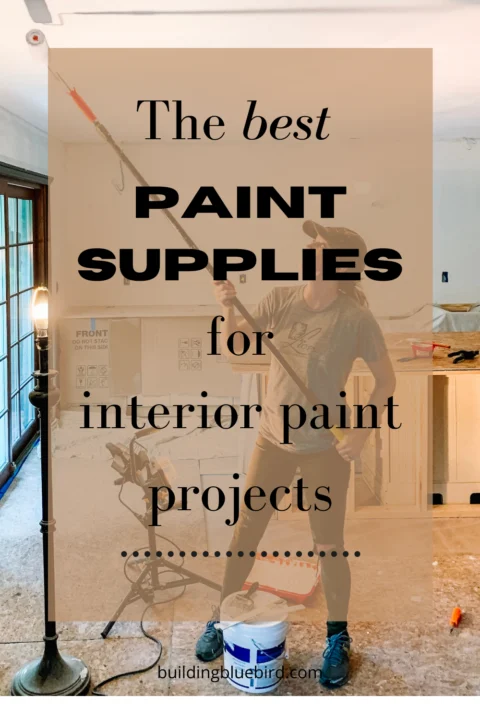
Choosing to paint interior walls yourself instead of hiring a professional painter is a great way to save money! The cost of labor adds up quickly and I prefer to use that money in other areas of our home. With the right painting tools and a little practice, you can achieve professional-looking results for a fraction of the price.
Table of Contents
- The Best Paint Supplies When Painting Interior Spaces
- 1 | Paint Cleaning Comb
- 2 | Plastic Bags
- 3 | Sandpaper and Sanding Blocks
- 4 | Paint Brushes
- 5 | Paint Rollers and Roller Covers
- 6 | Paint Trays and Liners
- 7 | Extension Poles
- 8 | Stir Sticks
- 9 | Paint Can Opener
- 10 | Putty Knife
- 11 | Spackle and Patch Compound
- 12 | Caulking Gun and Caulk
- 13 | Paint Scraper
- 14 | Drop Cloths or Plastic Sheeting
- 15 | Painter’s Pyramid Stands
- 16 | Edge Painter
- 17 | Masking Film and Tape Dispenser
- 18 | Disposable Gloves
- 19 | Rags and Cloths
- 22 | Painter’s Tape
- 21 | Paint Sprayer (optional)
- 22 | Ladder, Step Stool or Platform
- 23 | Paint
- More Painting Posts You Will Love…
Here are the 23 must-have painting tools every beginner painter should consider:
The Best Paint Supplies When Painting Interior Spaces
Affiliate links are used in this post. When products are purchased through these links I earn a small commission at no additional cost to you.

1 | Paint Cleaning Comb
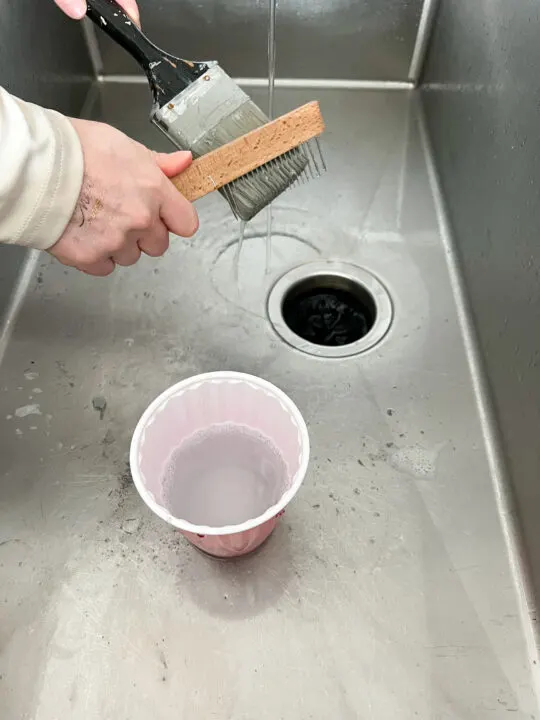
This tool is so great for cleaning dirty paintbrushes! Using warm water and dish detergent, comb the metal teeth through the bristles to remove paint clumps.
Purchasing a good brush and properly cleaning the paintbrush after your project will allow you to use the same brush over and over again!
2 | Plastic Bags
This is one of my favorite painting hacks! If I am painting multiple days or need to take a break for a few hours, I pop the paintbrush into a plastic bag.
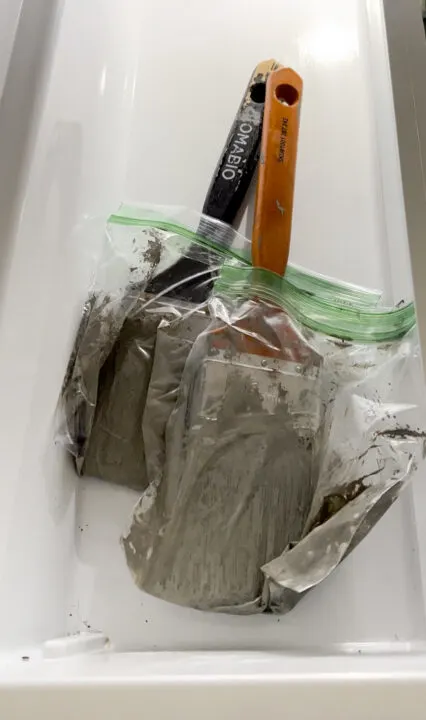
Then I put the sealed paintbrush into the fridge to prevent the paint from drying out. My least favorite task with a painting job is cleaning the paintbrushes so this painting tool is a must for me!
3 | Sandpaper and Sanding Blocks

Smooth surfaces are key to a professional finish. Sandpaper and sanding blocks help you prepare walls, trim, and other surfaces by removing imperfections and creating a smooth base.
4 | Paint Brushes
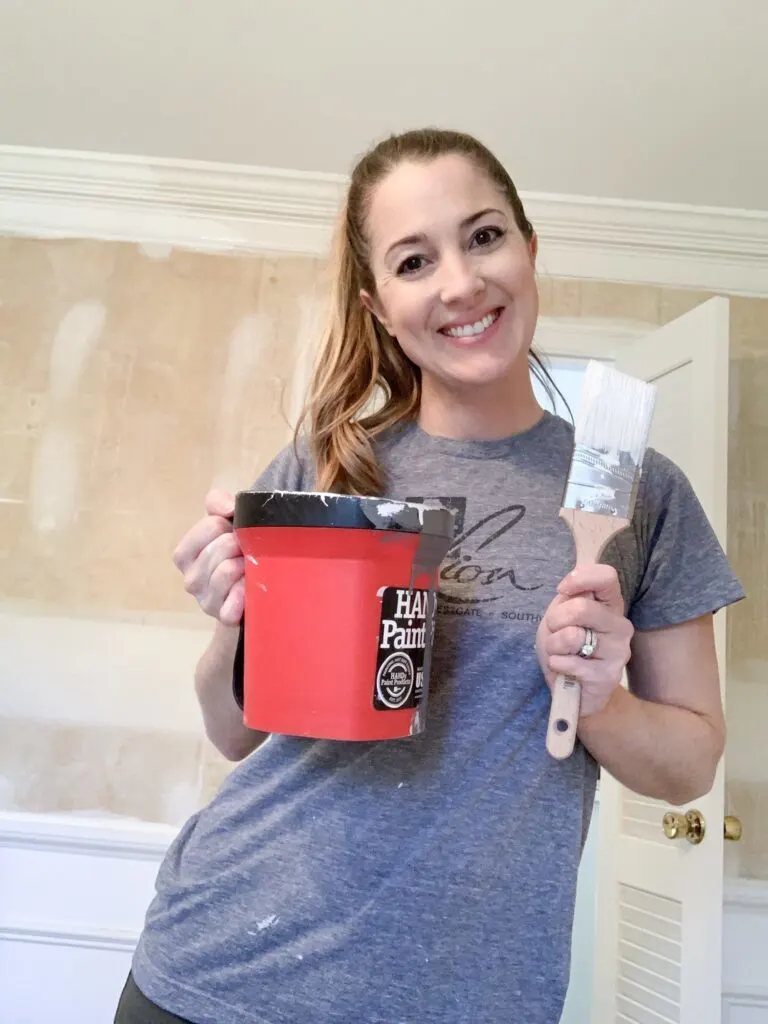
Invest in a variety of high-quality paint brushes. Angled, synthetic brushes are great for cutting in edges, while flat brushes are ideal for larger, flat surfaces.
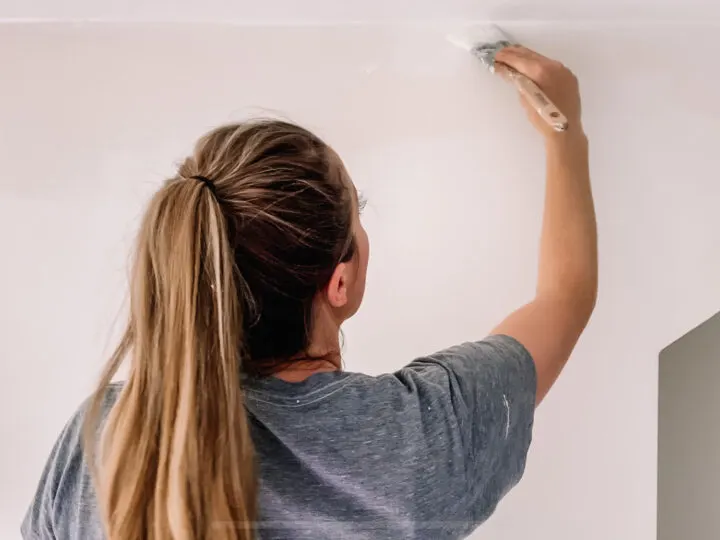
A 2 inch angled brush is my go-to paintbrush for DIY projects. The angle makes it easier to cut around the edges easily and create a nice straight line.
5 | Paint Rollers and Roller Covers
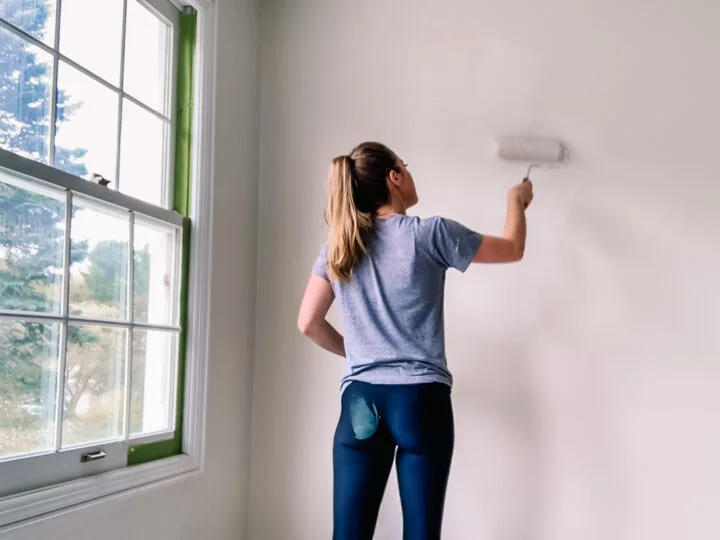
For painting walls and ceilings, paint rollers are essential. For most paint projects in my own home, I use a 9 inch paint roller frame. This size is easy to use and allows painters to evenly apply paint onto surfaces.
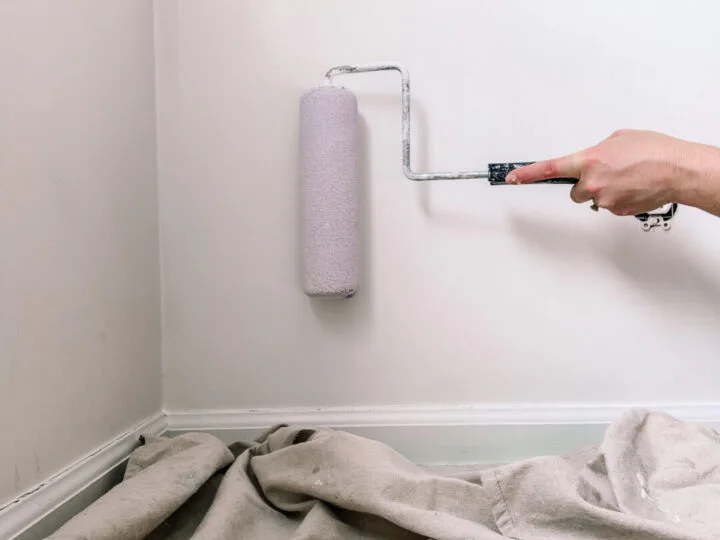
Choose roller covers with the appropriate nap length for the surface you’re painting. For more textured walls and surfaces, like stucco walls, a thicker nap is a good idea.
For smoother surfaces like a ceiling, a shorter nap will be best. My most frequently used nap length is 3/8 inch.
6 | Paint Trays and Liners
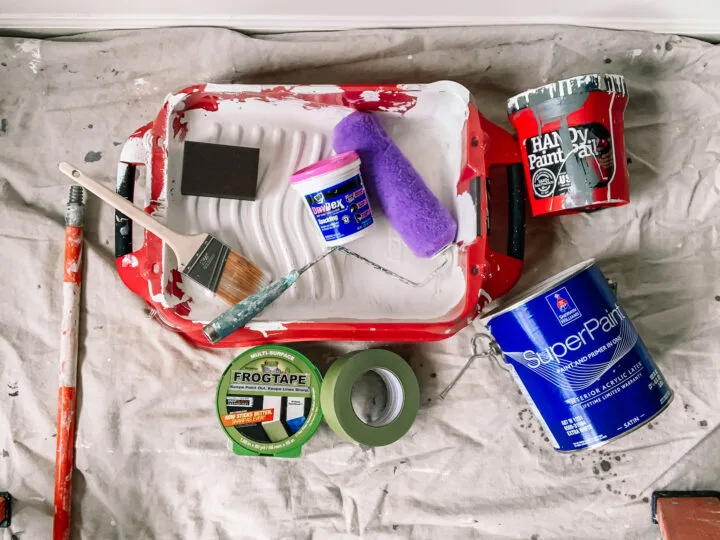
Paint trays and liners are necessary for holding paint and loading your roller evenly. The Handy Paint Pail roller tray has a deep base to hold a lot of paint and is incredibly sturdy. Plastic tray liners make cleanup easier and prolong the life of your paint trays.

The Handy Paint Pail cup is another one of my favorite paint tools because they are easy to handle while standing on a ladder. The cup also includes a magnet at the top that will hold the paintbrush and prevent it from falling into the paint.
7 | Extension Poles
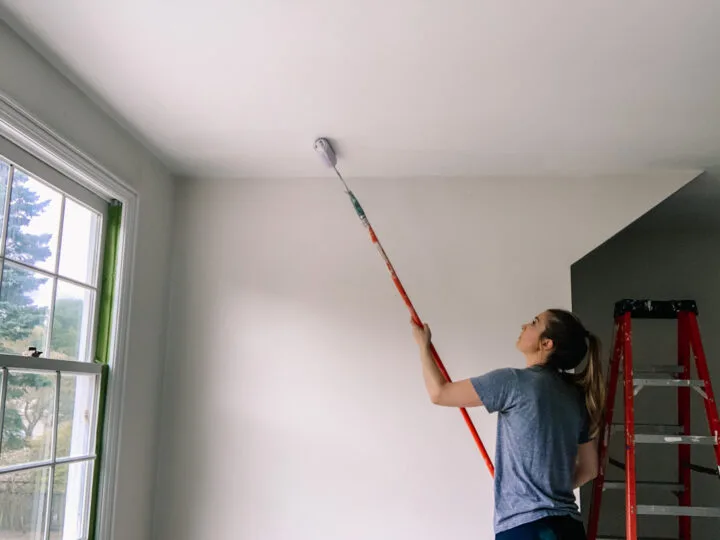
Extension poles attach to your roller handles, allowing you to reach high ceilings and walls without a ladder. They can attach to paint edgers and attachments to extend the reach of your paintbrush.
8 | Stir Sticks
Stir sticks are essential for mixing paint thoroughly before application to ensure consistent color and texture.
9 | Paint Can Opener
A paint can opener makes it easy to open and reseal paint cans without damaging the lid, ensuring your paint stays fresh. A flat-head screwdriver works well, too.
10 | Putty Knife
A putty knife is used for applying and smoothing filler or putty on holes and cracks, ensuring a smooth, even surface for painting. A putty knife is also a great tool for scraping up dried paint drips on solid surface floors.
11 | Spackle and Patch Compound

Spackle and patch compound are necessary for filling holes, cracks, and imperfections in walls before painting. For larger areas to patch, I use All Purpose joint compound, which I purchase at Home Depot or any other local hardware store.
When filling smaller holes in drywall, I use spackle and apply it with my finger or a putty knife.
12 | Caulking Gun and Caulk

Use a caulking gun and caulk to seal gaps and joints between surfaces. This kind of tool creates a seamless finish and prevents paint from seeping into unwanted areas.
13 | Paint Scraper
A paint scraper is useful for removing old, peeling paint and preparing surfaces for a new coat.
14 | Drop Cloths or Plastic Sheeting

Protect your floors and furniture from paint splatters with durable drop cloths. Canvas drop cloths are reusable and less slippery than a plastic drop cloth. You can also purchase canvas ones with rubber backing to make it more slip resistant.
For a more affordable option, consider using old bed sheets.
15 | Painter’s Pyramid Stands
Painter’s pyramids hold your project off the ground, allowing you to paint all sides without waiting for one side to dry. This painting tool is essential when painting cabinet doors.
16 | Edge Painter
An edge painter is a handy tool for cutting in along edges and corners with precision, reducing the need for painter’s tape. I find this painting tool very helpful when I have to paint clean edges against the ceiling in a room with cathedral ceilings.
17 | Masking Film and Tape Dispenser
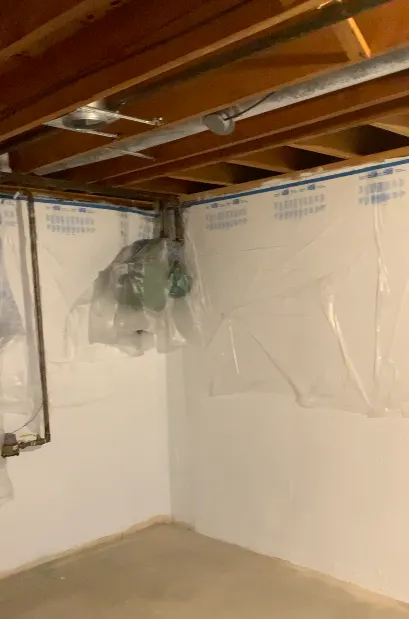
Masking film is a plastic sheeting that clings to surfaces, making it easy to cover and protect large areas quickly. A tape dispenser speeds up the process of applying painter’s tape. I like using this tool when I use the paint sprayer and paint overspray is inevitable.
18 | Disposable Gloves
Protect your hands from paint and chemicals with disposable gloves. They are particularly useful when working with solvents and stains. I skip the gloves when handling standard latex paint.
19 | Rags and Cloths
Keep plenty of rags and cloths on hand for wiping up spills, cleaning brushes, and general cleanup during and after your project. I prefer to use a damp rag to quickly wipe up paint smudges when doing trim work.
If you prefer packaged wet wipes, Crocodile Cloths include a gentle cleaning agent and are a great option for cleaning up paint spills.
22 | Painter’s Tape
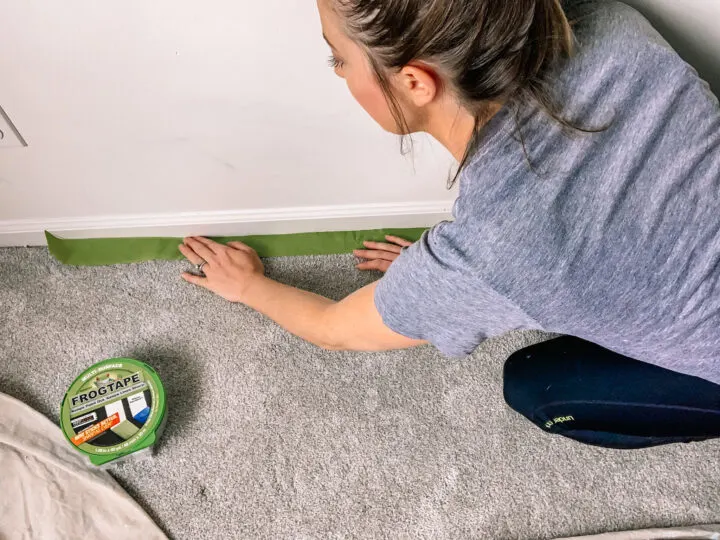
If you are new to painting interior spaces, painter’s tape is crucial for achieving clean, sharp lines and protecting surfaces you don’t want to paint. It’s perfect for masking off edges, windows, and trim. For more delicate surfaces, choose a painters tape that will prevent damage or pull off existing paint.
As you become more experienced painting interiors you may feel more comfortable painting clean lines without the painters tape.
21 | Paint Sprayer (optional)

*Check out the tutorial for how to paint a basement ceiling.
A paint sprayer is a fantastic tool for large projects or painting textured or uneven surfaces. I used the sprayer in our basement to paint the open joists and pipes on the ceiling.
If you use a paint sprayer, make sure you have the appropriate protective gear. When spraying the ceiling, I wore a full protective suit, glasses, and an N95 mask.
22 | Ladder, Step Stool or Platform

The aluminum platform is so great when painting the ceiling trim! I also use a step stool and ladder, but I have to step down and move them much more often than the platform. For higher ceilings, an extension ladder is important to reach the top of the walls.
23 | Paint
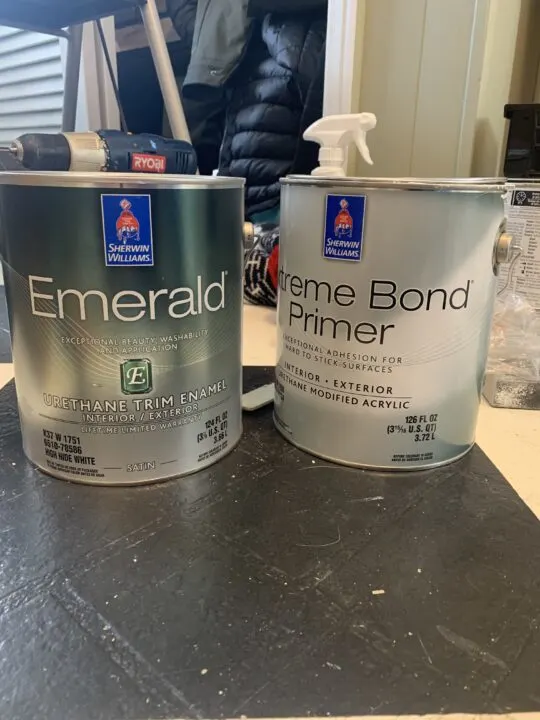
The most common type of paints used for interior spaces are latex, water-based paints. Latex paint has lower VOC, or odor, than the other options and is easy to clean, making it a popular choice with homeowners.
Different Types of Paint
- Latex paint: Water-based paint product
- Oil-based paint
- Acrylic paint
- Paint Stain
- Paint Primer
- Chalk Paint: Popular paint option for painting furniture
- Epoxy Paint: Durable paint product, perfect for painting floors that get lots of wear and tear
Having the right tools can make all the difference in the outcome of your painting project. By equipping yourself with these must-have painting tools, you’ll be well-prepared to tackle any project with confidence and achieve professional-quality results.
More Painting Posts You Will Love…
- How to Paint a Room in 7 Easy Steps
- How to paint a room with carpeting
- Moody, rich paint colors to try in your home
- The perfect neutral paint colors for your home
- How to choose your paint sheen
- Choosing the best paint colors for your home
- I applied latex over oil-based paint – How I fixed it



Jennifer Laura
Wednesday 31st of March 2021
I really need to get a paint sprayer, it would come in so handy! We always paint too, the only time we considered not painting was was in our last house and we really wanted to paint the ceiling and it was SO high. We ended up leaving it, but I still want to paint it, lol.
lindseymahoney
Wednesday 31st of March 2021
Yes! I am getting more comfortable using it which has been nice. We just painted our basement ceiling and it was a great spot to practice since it wasn't super noticeable when I did get an even finish.